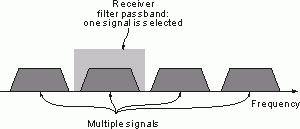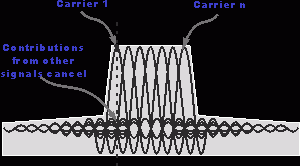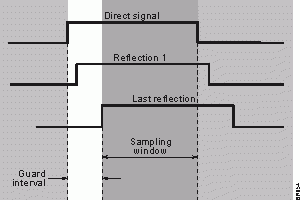What is OFDM? (Orthogonal Frequency Division Multiplexing)
OFDM: Orthogonal Frequency Division Multiplexing, is a form of signal modulation that divides a high data rate modulating stream placing them onto many slowly modulated narrowband close-spaced subcarriers, and in this way is less sensitive to frequency selective fading.
Orthogonal Frequency Division Multiplexing or OFDM is a modulation format that is being used for many of the latest wireless and telecommunications standards.
OFDM has been adopted in the Wi-Fi arena where the standards like 802.11a, 802.11n, 802.11ac and more. It has also been chosen for the cellular telecommunications standard LTE / LTE-A, and in addition to this it has been adopted by other standards such as WiMAX and many more.
Orthogonal frequency division multiplexing has also been adopted for a number of broadcast standards from DAB Digital Radio to the Digital Video Broadcast standards, DVB. It has also been adopted for other broadcast systems as well including Digital Radio Mondiale used for the long medium and short wave bands.
Although OFDM, orthogonal frequency division multiplexing is more complicated than earlier forms of signal format, it provides some distinct advantages in terms of data transmission, especially where high data rates are needed along with relatively wide bandwidths.
What is OFDM? – The concept
OFDM is a form of multicarrier modulation. An OFDM signal consists of a number of closely spaced modulated carriers. When modulation of any form – voice, data, etc. is applied to a carrier, then sidebands spread out either side. It is necessary for a receiver to be able to receive the whole signal to be able to successfully demodulate the data. As a result when signals are transmitted close to one another they must be spaced so that the receiver can separate them using a filter and there must be a guard band between them. This is not the case with OFDM. Although the sidebands from each carrier overlap, they can still be received without the interference that might be expected because they are orthogonal to each another. This is achieved by having the carrier spacing equal to the reciprocal of the symbol period.

To see how OFDM works, it is necessary to look at the receiver. This acts as a bank of demodulators, translating each carrier down to DC. The resulting signal is integrated over the symbol period to regenerate the data from that carrier. The same demodulator also demodulates the other carriers. As the carrier spacing equal to the reciprocal of the symbol period means that they will have a whole number of cycles in the symbol period and their contribution will sum to zero – in other words there is no interference contribution.

One requirement of the OFDM transmitting and receiving systems is that they must be linear. Any non-linearity will cause interference between the carriers as a result of inter-modulation distortion. This will introduce unwanted signals that would cause interference and impair the orthogonality of the transmission.
In terms of the equipment to be used the high peak to average ratio of multi-carrier systems such as OFDM requires the RF final amplifier on the output of the transmitter to be able to handle the peaks whilst the average power is much lower and this leads to inefficiency. In some systems the peaks are limited. Although this introduces distortion that results in a higher level of data errors, the system can rely on the error correction to remove them.
Data on OFDM
The data to be transmitted on an OFDM signal is spread across the carriers of the signal, each carrier taking part of the payload. This reduces the data rate taken by each carrier. The lower data rate has the advantage that interference from reflections is much less critical. This is achieved by adding a guard band time or guard interval into the system. This ensures that the data is only sampled when the signal is stable and no new delayed signals arrive that would alter the timing and phase of the signal.

The distribution of the data across a large number of carriers in the OFDM signal has some further advantages. Nulls caused by multi-path effects or interference on a given frequency only affect a small number of the carriers, the remaining ones being received correctly. By using error-coding techniques, which does mean adding further data to the transmitted signal, it enables many or all of the corrupted data to be reconstructed within the receiver. This can be done because the error correction code is transmitted in a different part of the signal.
OFDM advantages & disadvantages
OFDM advantages
OFDM has been used in many high data rate wireless systems because of the many advantages it provides.
- Immunity to selective fading: One of the main advantages of OFDM is that is more resistant to frequency selective fading than single carrier systems because it divides the overall channel into multiple narrowband signals that are affected individually as flat fading sub-channels.
- Resilience to interference: Interference appearing on a channel may be bandwidth limited and in this way will not affect all the sub-channels. This means that not all the data is lost.
- Spectrum efficiency: Using close-spaced overlapping sub-carriers, a significant OFDM advantage is that it makes efficient use of the available spectrum.
- Resilient to ISI: Another advantage of OFDM is that it is very resilient to inter-symbol and inter-frame interference. This results from the low data rate on each of the sub-channels.
- Resilient to narrow-band effects: Using adequate channel coding and interleaving it is possible to recover symbols lost due to the frequency selectivity of the channel and narrow band interference. Not all the data is lost.
- Simpler channel equalisation: One of the issues with CDMA systems was the complexity of the channel equalisation which had to be applied across the whole channel. An advantage of OFDM is that using multiple sub-channels, the channel equalization becomes much simpler.
OFDM disadvantages
Whilst OFDM has been widely used, there are still a few disadvantages to its use which need to be addressed when considering its use.
- High peak to average power ratio: An OFDM signal has a noise like amplitude variation and has a relatively high large dynamic range, or peak to average power ratio. This impacts the RF amplifier efficiency as the amplifiers need to be linear and accommodate the large amplitude variations and these factors mean the amplifier cannot operate with a high efficiency level.
- Sensitive to carrier offset and drift: Another disadvantage of OFDM is that is sensitive to carrier frequency offset and drift. Single carrier systems are less sensitive.
OFDM variants
There are several other variants of OFDM for which the initials are seen in the technical literature. These follow the basic format for OFDM, but have additional attributes or variations:
- COFDM: Coded Orthogonal frequency division multiplexing. A form of OFDM where error correction coding is incorporated into the signal.
- Flash OFDM: This is a variant of OFDM that was developed by Flarion and it is a fast hopped form of OFDM. It uses multiple tones and fast hopping to spread signals over a given spectrum band.
- OFDMA: Orthogonal frequency division multiple access. A scheme used to provide a multiple access capability for applications such as cellular telecommunications when using OFDM technologies.
- VOFDM: Vector OFDM. This form of OFDM uses the concept of MIMO technology. It is being developed by CISCO Systems. MIMO stands for Multiple Input Multiple output and it uses multiple antennas to transmit and receive the signals so that multi-path effects can be utilised to enhance the signal reception and improve the transmission speeds that can be supported.
- WOFDM: Wideband OFDM. The concept of this form of OFDM is that it uses a degree of spacing between the channels that is large enough that any frequency errors between transmitter and receiver do not affect the performance. It is particularly applicable to Wi-Fi systems.
Each of these forms of OFDM utilise the same basic concept of using close spaced orthogonal carriers each carrying low data rate signals. During the demodulation phase the data is then combined to provide the complete signal.
OFDM, orthogonal frequency division multiplexing has gained a significant presence in the wireless market place. The combination of high data capacity, high spectral efficiency, and its resilience to interference as a result of multi-path effects means that it is ideal for the high data applications that have become a major factor in today’s communications scene.
You must be logged in to post a comment.